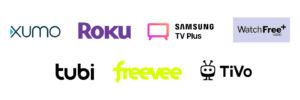Insider Intelligence reports a forecasted 8% drop in total advertising for live, linear TV in 2023.
But what exactly does this indicate? This prediction certainly highlights consumers’ preference for streaming video. But in Q1 of 2023, subscription video-on-demand (SVOD) lost 2.2 million subscribers. We are seeing more consumers opt for ad-supported streaming, and these platforms have grown in popularity within the past year with 86% of streamers watching ad-supported content.
So what if consumers could get the best of both: a linear experience while using a free, ad-supported platform? This is where we see FAST (Free Ad-Supported Streaming TV) take center stage.
What is Free Ad-Supported Streaming TV (FAST)?
FAST is a linear alternative that gives consumers access to select channels, emulating the experience of traditional linear television but without the burden of a subscription fee. Consumers can watch this programmed content as they please, allowing them to watch shows, movies, news channels, and more across a variety of genres.
FAST has seen rapid growth within the past year and is expected to maintain that momentum, with revenue forecasted to reach $7.2 billion by the end of 2023. In fact, a recent Statista study reported that 57% of U.S. TV viewers watched ad-supported streaming TV on platforms such as Tubi and the Roku Channel in 2023.
Why is FAST important?
The current economic landscape has shifted consumer behavior within the past year, resulting in more price-conscious spending habits. The streaming market is highly saturated as multiple platforms compete for viewers, and many consumers are experiencing subscription fatigue (the average U.S. household has four streaming subscriptions!).
“Because FAST mimics traditional television programming, this fuels faster adoption and provides seamless access to a wider range of content from different media companies, as opposed to a single media company that typical AVOD services provide on CTV and OTT.”
– Otniel Calderon, Digilant Sales Engineering Manager
FAST is making a splash (or perhaps, causing a tsunami) in the CTV space, as it has the potential to significantly change the current CTV landscape by attracting a new wave of cord-cutters.
What is the difference between advertising-based video-on-demand (AVOD) and FAST?
While advertising-based video on demand (AVOD) and FAST both rely on ads to monetize their services, they differ in distribution methods. AVOD provides content on-demand, in which the user initiates the individual viewing session and chooses the content they want to watch. FAST programs provide linear, scheduled programming, and this content is delivered to mass audiences on connected devices.
Say a person opens their ad-supported subscription with Hulu, they will have access to every episode of ABC’s Modern Family for their choosing. When opening Samsung TV+, the user can watch whatever episode of Hell’s Kitchen that happens to be playing. Here are a few examples of notable FAST channels:

Why should advertisers pay attention to FAST Channels?
1. Reach the growing cord-cutting audience
Each year, advertisers are seeing more and more consumers cutting the cord. What FAST provides is a quick alternative for previously linear viewers to consume content, especially as these programs are available on major smart TVs such as Samsung, Vizio, and LG. With 77% of US households owning a smart TV, advertisers can reach the growing FAST audience.
This also applies to current streamers. Eighty-seven percent of streamers are likely to try a new FAST service in the next year. FAST channels take away the burden of having to choose a show or movie – a desirable feature on linear television.
2. Affordable Advertising
Advertising on FAST channels is a cost-effective way for brands to reach a wider audience in comparison to linear TV networks and other AVOD services. FAST has the potential to increase competition among publishers, which could in turn lower CPMs.
3. Enhanced targeting / measurement capabilities
Advertisers reap the benefits of a digital channel to utilize dynamic targeting and granular tracking when advertising on FAST channels. Additionally, advertisers may use contextual targeting in their ad buys, appealing to niche audiences or specific demographics. This allows campaigns to be run with greater precision, which can help improve overall performance.
Once campaigns are run, advertisers can measure the results of their FAST channel advertising campaigns with a variety of metrics, including reach, frequency, and engagement. This gives advertisers the valuable insights needed to make data-driven decisions on how to best optimize their advertisements moving forward.
FAST Advertising with Digilant
FAST is certainly drawing attention in the video advertising space. With over 1400 channels across 22 major providers, FAST is growing and shouldn’t be ignored.
At Digilant, our partners with platforms like Samsung TV +, Amazon’s Freevee, and Youtube allow us to tap into FAST channels and create data-driven strategies to reach this wide audience. Want to learn more about our offerings? Contact us today.